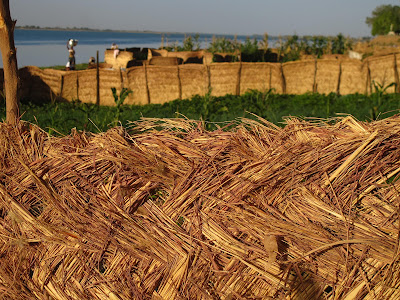It was the best of Mali, it was the worst of Mali. Segou and Djenne - both steeped in centuries of West African history, both enjoy the lifeblood of the river Niger, both highlighting clearly the highs and lows of the peculiar nation of Mali, both home to an impressive array of hats.
Almost all of Malis turbulent history seems to be condensed in Segou. The centuries-old pirogues; mud-walled houses and wide-brimmed red hats (like something Noddy would wear on safari) all hark back to the great Bambara empire that rose there and reached its zenith around the 17th century. Its decline began only after it fell at the hands of an Islamic zealot named El-Hadj Omar Tall who had launched a jihad across the whole region to try get the local animists to discard their wooden dolls and late morning lie-ins in favour of Islam. It is not known if El-Hadj Omar was, infact, tall. But given that the name was self-anointed and that he went about subjugating millions of West Africans, scholars maintain that he may have been compensating for something. The effect of this crusade was felt by myself and Tough Guy every morning at 4am. Then there were the fading colonial buildings, baguettes and statues of men with twirly moustaches which reveal the period of French colonisation at the beginning of the 20th century. And, of course, the post-independence period as visible by the large numbers of homeless children asking for "cadeau" and the army uniforms asking for "passport"
Djenne, only 400kms to the north, ran a different course. It voluntarily converted to Islam in the 13th century and, together with Timbuktu, was seen as Africas greatest outpost of Islamic scholarship and fashionable skullcaps. It was also a major trade hub where slaves and gold from the south were traded for - believe it - salt from the north. It is only after you have eaten Malis cuisine that you realise that you too would likely auction off your family heirlooms for a sachet of Cerebos to try alter the flavour. Alas it began its decline around the same time as the Bambaras as a result of invasion, and subsequent neglect, by the Moroccans who, no doubt, rode in with their rotten grins and promises of a good deal. Just for them. One time offer.
An unfortunate off-shoot of these centuries of Islamic tutelage is the encouraged practise of child begging. Children would be sent from distant countries to Djenne to learn the Koran and part of the deal is that they had to fend for themselves by begging. This practise continues today in Djenne where half the children can be seen pouring over their wooden tablets trying to cling to passages of scripture while the other half are pouring over your pockets trying to cling to your wallet. Throw in the mighty tourist attraction of the Great Mosque there and it doesn't make for a quiet stay as a tourist.
So, history aside, the main differences between the two places is that Segou is pure magic while Djenne is quite annoying. So while afternoons in Segou were widdled away watching pirogues laze up and down the Niger and locals casually watering their veggie gardens; in Djenne they were spent swatting away children in a feeding frenzy for gifts or photographs. So it seems, unfortunately, that this new era - the tourism dynasty - is leaving as indelible a footprint on the area as any of the previous epochs have. I just pray it doesn't affect their choice of headwear.













No comments:
Post a Comment